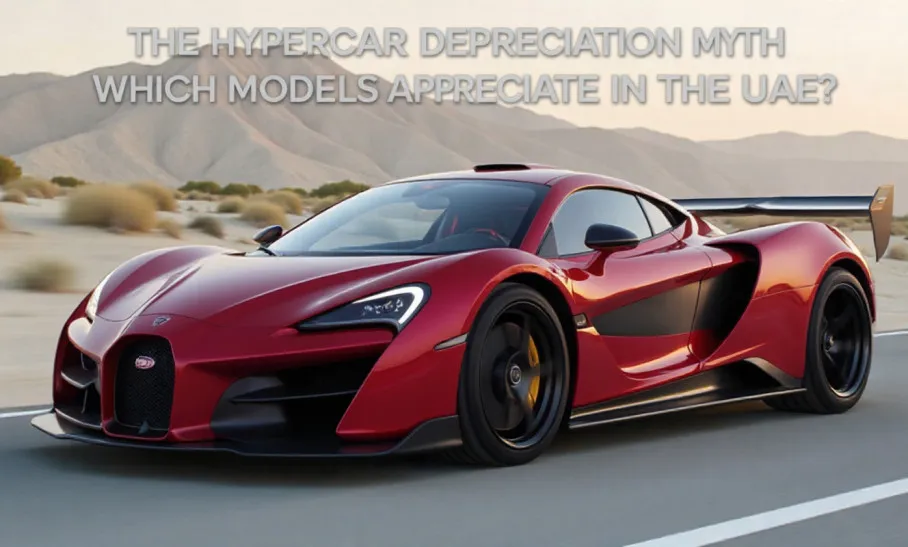The Hypercar Depreciation Myth: Which Models Gain Value in the UAE Market?
Introduction
The UAE’s luxury car scene is unlike anywhere else in the world. While most vehicles lose value the moment they leave the showroom, a select group of hypercars — especially those with limited production numbers — seem to defy the rules of depreciation.
In Dubai, these ultra-rare machines are not just modes of transport; they’re rolling investments. But which hypercars truly appreciate in value? And what drives this market dynamic in the Emirates?
Let’s explore the myth — and reality — of hypercar depreciation in the UAE.
Why Do Most Cars Depreciate While Hypercars Don’t?
Most cars lose 20–30% of their value in the first year. But hypercars operate in a different economic universe. They are built in such limited numbers, often fewer than 100 units globally, that demand far exceeds supply.
In Dubai, where collectors value exclusivity and brand prestige, a well-kept hypercar with the right provenance can appreciate significantly — sometimes even doubling its value within a few years.
The equation is simple:
Exclusivity + Provenance + Performance + Cultural Demand = Appreciation.
Which Hypercar Brands Retain or Increase Their Value in the UAE?
Here’s a look at the top-performing models in Dubai’s hypercar market:
Q&A: Inside Dubai’s Hypercar Collector Culture
Q1: Why is Dubai such a strong market for appreciating hypercars?
A: Dubai’s economy, tax-free environment, and concentration of high-net-worth individuals create the perfect breeding ground for automotive collectibles. Many hypercars here are kept in pristine, climate-controlled garages and driven sparingly, preserving their investment potential.
Moreover, Dubai’s reputation as a global luxury hub attracts international buyers to events like the Dubai International Motor Show and Top Marques, further driving resale value.
Q2: Do hypercars really make better investments than real estate or stocks?
A: In some cases — yes. While not as liquid as traditional assets, certain hypercars have outperformed property and stock portfolios over the past decade. For instance, the Ferrari LaFerrari, initially priced around AED 5 million, now trades for upwards of AED 10 million depending on condition and mileage.
However, this only applies to ultra-rare, limited-production models. Mass-produced supercars like the Ferrari F8 Tributo or Lamborghini Huracán will still depreciate.
Q3: What factors determine a hypercar’s long-term value in Dubai?
A:
- Production Rarity: Fewer units mean higher exclusivity.
- Brand Legacy: Established marques like Ferrari, Bugatti, and Pagani command stronger resale confidence.
- Condition & Mileage: UAE buyers prioritize immaculate, low-kilometer cars.
- Color & Customization: Factory-original specs often fetch higher prices than overly modified examples.
- Documentation: Service history and provenance (first owner, delivery details, etc.) are key to valuation.
Q4: How does the UAE’s tax-free policy affect the hypercar resale market?
A: The absence of import and capital gains taxes gives Dubai an edge over other collector markets. Buyers can trade, store, or resell vehicles with minimal bureaucratic friction — making the UAE one of the world’s most active hypercar trading hubs.
Collectors from Europe and Asia often ship their vehicles here for auction due to favorable resale margins and buyer demand.
Q5: Are hybrid and electric hypercars gaining traction among collectors?
A: Absolutely. The Porsche 918 Spyder and Ferrari SF90 have proven that performance electrification can hold collector appeal. With Dubai’s shift toward sustainability and the government’s EV incentives, models like the Lotus Evija and Rimac Nevera are attracting early investor interest.
As these vehicles represent a new era of engineering, their “first-generation” value could make them future classics.
Q6: Which hypercars are expected to appreciate next in the UAE market?
A: Experts predict that the following models could see strong appreciation over the next five years:
The Global Perspective: Hypercar Value Trends Beyond the UAE
While Dubai stands out as a luxury car capital, the appreciation of hypercars is also part of a broader global phenomenon. According to Hagerty’s Global Collector Car Index, values for limited-production models such as the Ferrari LaFerrari and McLaren P1 have risen by over 50% since 2020. Meanwhile, RM Sotheby’s and Bonhams report record-breaking auction results for hypercars originally sold in the UAE — often outperforming similar listings from Europe or the US. This data reinforces Dubai’s influence as both a collector hotspot and an international price benchmark for rare vehicles.
The Collector’s Strategy: Buy Smart, Hold Long
For serious investors, the secret isn’t just buying a rare car — it’s timing the market. Acquiring the right hypercar early in its production window, maintaining it under professional care, and holding it for 5–10 years can yield impressive returns.
Dubai’s combination of climate, wealth, and passion for exclusivity makes it one of the safest places in the world to hold such assets.
Explore More:
- Which Used Car Brands Hold Value Best in the UAE (3-Year Data)
- How Car Depreciation Works in Dubai | Used Car Buyers Guide
Final Paragraph
Dubai’s hypercar market continues to challenge the global depreciation narrative, especially for ultra-rare, limited-edition models from brands like Ferrari, Pagani, and Bugatti. If you’re exploring high-value investments or searching for used luxury cars and hypercars in Dubai, visit www.autotraders.ae — your trusted destination for buying and selling premium vehicles in the UAE.

